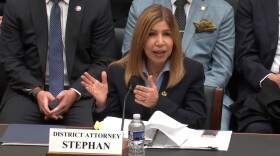GLORIA PENNER (Host): Is the local housing crisis over? Recent reports on rising home prices and a nationwide dip in foreclosures are indicating that might be the case. But some experts are looking at this through a more cautious lens. Joining me now to talk about the local housing market is San Diego Union-Tribune reporter Roger Showley. Roger, welcome.
ROGER SHOWLEY (San Diego Union-Tribune Reporter): Thank you.
PENNER: All right. So I read your article in Monday’s paper, and it said that San Diego home values are rising at a higher rate than any other market in the nation, according to a report by Zillow.com. What does that tell us about our market, what does that mean?
SHOWLEY: Well it tells us something that we’ve known for some years, and that is that San Diego is leading that market nationally in housing prices. We went down first, among most of the metro areas, and we seem to be bottoming out and maybe coming out of it first.
PENNER: But there seems to be a difference maybe between housing prices and home values. What’s the difference?
SHOWLEY: Well, values – the price is what people are buying and selling the houses at today. The value is what the homes are worth, whether they’re being sold or not. So the people who are selling now are generally selling because they have to sell. Whereas people who are owning and aren’t selling are holding back. And I’ve often thought lately that there’s quite a buildup of people who should be selling now because they’ve been in their houses for 10 years or something, they want to move on, or they’re afraid that the prices are not going to be high enough for them to get. So the values are going one way, and the prices are going another way, and they should be going in tandem.
PENNER: But they’re not. Well, I’m referring now to a story that you wrote about how San Diego County resale house prices did rise, 14.7 percent in the first quarter, to a median of $370,000.
SHOWLEY: Right. What’s so strange about this is, the prices reflect what’s going on right now. So if there’re a lot of low prices going out, then the median would be low. If there’re a lot of more higher priced homes being sold then the median would go up. So it reflects what they call a market mix, of what’s being sold in any given month. So the DataQuick numbers that show the prices, are showing an increase and so are the realtors, because that’s where the prices are going, but the values are not rising so much at an individual level.
PENNER: Doesn’t it depend on where you live, on your neighborhood?
SHOWLEY: It does, yes, real estate is local, down to the, first the metro area, then the zip code level, and then the neighborhood, and then your actual block. So ultimately prices are what people pay for something. The market can be anything, but if I’m not going to buy your house then it’s not worth anything, if I want to buy your house then it’s going to be worth what I pay for it.
PENNER: Then, where’s the most activity happening right now? I mean, am I living, let’s say in a place where houses are selling?
SHOWLEY: The most activity is in the lower end, around the median, around $360,000 home prices. Anything under $300,000 is selling in two days. In multiple bids, people are overbidding each other to try and buy these starter homes. Investors are edging out the owner-occupants. As you move up the housing price levels, there are fewer and fewer people who are buying, because they can’t get financing, or the houses aren’t what they want.
PENNER: You call these under $300,000 starter homes?
SHOWLEY: Yes.
PENNER: Is that because this will be the first home that somebody buys?
SHOWLEY: Right.
PENNER: Does it have anything to do, for example, for foreclosures? I see that Bank of America sent out hundreds of letters to delinquent home owners in north San Diego, and notifying them that their houses would be put up for auction. What impact would that have on the market?
SHOWLEY: I don’t know if that’s a scare tactic, or if they’re actually serious about it. Because if they put too many houses on the market at once, they’re going to get less money themselves – the bank itself. So the last year or two, the banks have been very careful about how many homes they put on the market at any given time. So maybe scaring people to get with it and pay their mortgages or whatever, there’s a problem of what they call strategic defaults, where people could pay but they just won’t, so I imagine some banks, maybe Bank of America, want to be a little bit more tough with people.
PENNER: Explain that part about where people could pay their mortgages, but won’t? What would be the reason?
SHOWLEY: Well if you bought your house for $600,000, and you’re paying $3,000 a month, and your neighbors sold their house or went through foreclosure and maybe now it’s selling for $300,000, how many years will that house to take to get back up to your $600,000 level? So people who can pay the money, and they’re making enough, make the judgement that, forget it, I’m not going to wait.
PENNER: We have three elements here, we have default, we then have foreclosure, and we then have repossession.
SHOWLEY: And delinquency.
PENNER: And delinquency. So, how are we seeing numbers coming here?
SHOWLEY: Well I wrote down some numbers that are rather scary. Forty-two percent of homes are under water in San Diego County.
PENNER: Meaning that –
SHOWLEY: – they’re worth less than their mortgages.
PENNER: Right.
SHOWLEY: Twelve percent are delinquent. So there’s a certain portion of people who are paying even though their homes are worth less than what they paid for, or their mortgages. And other people are just not paying at all. So you probably heard stories about, about neighbors, and people who are just not paying their mortgage. They wait six months, a year sometimes, and the banks never call them. I hope they saved the money and not spent it on something. So they’re the delinquent people, and eventually the banks will put you into default, and eventually foreclosure.
PENNER: And so what does this all mean for San Diego’s housing market?
SHOWLEY: Well in spite of all that bad news, as you said, the prices are going up, values are edging up a little bit, the economy is improving slightly, unemployment may be going down a little bit, so little by little, some of these early signs of recovery are starting to develop in San Diego. And because our economy is somewhat stronger than other places, by the end of the year many people think we should be out of the woods. Not going up, they call it an L-shaped recovery, in other words, it’s gone down, but it’s not going to go up, it’s going to go flat, for some time.
PENNER: Thank you very much, Roger Showley.
SHOWLEY: You’re welcome.







